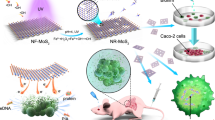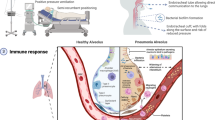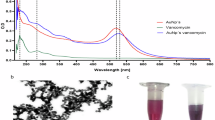Abstract
Ventilator-associated pneumonia (VAP) is a serious and costly clinical problem affecting pediatrics today. This device-related infection is thought to be directly linked to the colonization of the endotracheal tube (ETT) during long-term mechanical ventilation. Because of unspecific radiographic and clinical signs, VAP is especially difficult to diagnose in the pediatric population. Treatment with antibiotics is often ineffective, and VAP is associated with high morbidity, mortality, and medical costs. The use of nanomodified coatings on ETT may provide an effective strategy to prevent biofilm formation and ETT colonization. Nanoparticles such as selenium and iron oxide have been shown to penetrate into the biofilm reaching the protected cells antibiotics often miss. Moreover, nanoetching techniques can modify the topography of the ETT surface interfering with bacterial adhesion. This review seeks to examine the antimicrobial properties of both nanoparticles and nanomodified surfaces and to characterize their effectiveness at reducing bacterial colonization on ETT.
Similar content being viewed by others
Log in or create a free account to read this content
Gain free access to this article, as well as selected content from this journal and more on nature.com
or
Abbreviations
- ETT:
-
endotracheal tube
- HAI:
-
hospital acquired infection
- SCET:
-
silver-coated endotracheal tubes
- VAP:
-
ventilator-associated pneumonia
References
Klein J 2007 Probing the interactions of proteins and nanoparticles. Proc Natl Acad Sci USA 104: 2029–2030
Liu H, Webster TJ 2006 Nanomedicine for implants: a review of studies and necessary experimental tools. Biomaterials 28: 354–369
Lichter JA, Thompson MT, Delgadillo M, Nishikawa T, Rubner MF, Van Vliet KJ 2008 Substrata mechanical stiffness can regulate adhesion of viable bacteria. Biomacromolecules 9: 1571–1578
Diaz C, Cortizo MC, Schilardi PL, Saravia SG, Mele MA 2007 Influence of the nano-micro structure of the surface on bacterial adhesion. Mater Res 10: 11–14
Martone WJ, Jarvis WR, Culver DH, Haley RW 1993 Incidence and nature of endemic and epidemic nosocomial infections. In: Bennett JV, Brachman PS (eds) Hospital Infections. Little Brown, Boston, MA, pp 557–596
Richards MJ, Edwards JR, Culver DH, Gaynes RP 1999 Nosocomial infections in pediatric intensive care units in the United States. National Nosocomial Infections Surveillance System. Pediatrics 103: e39
Baltimore RS 2003 The difficulty of diagnosing ventilator-associated pneumonia. 112: 1420–1421
Bahrani-Mougeot FK, Paster BJ, Coleman S 2007 Molecular analysis of oral and respiratory bacterial species associated with ventilator-associated pneumonia. J Clin Microbiol 45: 1588–1593
Koerner RJ 1997 Contribution of endotracheal tubes to the pathogenesis of ventilator-associated pneumonia. J Hosp Infect 35: 83–89
Carsons SE 1989 Fibronectin in Health and Disease. CRC Press Inc, Boca Raton, FL
Marini JJ, Slutsky A 1998 Physiological Basis of Ventilatory Support. Marcel Dekker, New York, NY
Hartmann M, Guttmann J, Muller B, Hallmann T, Geiger K 1999 Reduction of the bacterial load by the silver-coated endotracheal tube (SCET) a laboratory investigation. Technol Health Care 7: 359–370
Kollef MH, Afessa B, Anzueto A, Veremakis C, Kerr KM, Margolis BD, Craven DE, Roberts PR, Arroliga AC, Hubmayr RD, Restrepo MI, Auger WR, Schinner R, NASCENT Investigation Group 2008 Silver-coated endotracheal tubes and incidence of ventilator-associated pneumonia: the NASCENT randomized trial. JAMA 300: 805–813
Roe D, Karandikar B, Bonn-Savage N, Gibbins B, Roullet JB 2008 Antimicrobial surface functionalization of plastic catheters by silver nanoparticles. J Antimicrob Chemother 61: 869–876
Taylor EN, Webster TJ 2009 The use of superparamagnetic nanoparticles for prosthetic biofilm prevention. Int J Nanomedicine 4: 145–152
Webster TJ, Siegel RW, Bizios R 2000 Enhanced functions of osteoblasts on nanophase ceramics. Biomaterials 21: 1803–1809
de Leiris J 2003 Biochemistry of free radicals. Heart Metab 19: 40–44
Clark LC, Dalkin B, Krongrad A, Combs GF Jr, Turnbull BW, Slate EH, Witherington R, Herlong JH, Janosko E, Carpenter D, Borosso C, Falk S, Rounder J 1998 Decreased incidence of prostate cancer with selenium supplementation: results of a double-blind cancer prevention trial. Br J Urol 81: 730–734
Söderholm KJ, Mukherjee R, Longmate J 1996 Filler leachability of composites stored in distilled water or artificial saliva. J Dent Res 75: 1692–1699
Stoodley P, Jacobsen A, Dunsmore BC, Purevdorj B, Wilson S, Lappin-Scott HM, Costerton JW 2001 The influence of fluid shear and AICI3 on the material properties of Pseudomonas aeruginosa PAO1 and Desulfovibrio sp. EX265 biofilms. Water Sci Technol 43: 113–120
Ghannoum MA, O'Toole GA 2004 Microbial Biofilms. ASM Press, Washington, DC
Author information
Authors and Affiliations
Corresponding author
Additional information
Supported, in part, by the Rhode Island STAC Fund.
Rights and permissions
About this article
Cite this article
Machado, M., Cheng, D., Tarquinio, K. et al. Nanotechnology: Pediatric Applications. Pediatr Res 67, 500–504 (2010). https://doi.org/10.1203/PDR.0b013e3181d68e78
Received:
Accepted:
Issue date:
DOI: https://doi.org/10.1203/PDR.0b013e3181d68e78
This article is cited by
-
Health implications of engineered nanoparticles in infants and children
World Journal of Pediatrics (2015)



